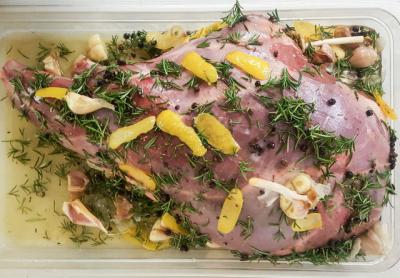Seasons by the Sea: Wild Things at Your Door

When your hunter friends stop by and drop off their bounty, do you know what to do with it? Deer? Goose? Wild duck?
I have fishermen and fisherwomen friends who drop off striped bass and blues and I am always thrilled and know what to do with them, but a lean, gamey duck that may have been feeding on fishy things? Not so much.
Pretty much every recipe online involves soaking or marinating wild birds in buttermilk or savory items, then wrapping in bacon to keep the meat moist, and not much guidance beyond that.
How wild is your game? This is a question worth asking. Most of the hunters I know prefer to go upstate, down south, or to Canada. Why? Fewer athletic fields, golf courses, manicured lawns, soy and corn fields, parks, and sod farms. In other words, fewer chemically treated food sources for these animals. If I see a group of deer munching happily on glysophate-laden bushes, shrubbery, and ornamental plants on Lily Pond Lane, I think “chemicals,” not “Oh, boy, Bambi Bolognese tonight!”
I am pro-hunting, and I have eaten venison in various forms and it was delicious. This can also be a valuable food source for many, through the donations of meat to local food banks and pantries.
If you are a duck hunter, you already know that the ducks that feed in freshwater taste better than sea ducks, which can be fishy tasting. Wood ducks and mallards are said to be the tastiest.
When I was growing up in Virginia, there was a popular restaurant in Washington, D.C., called Dominique’s, which specialized in all manner of exotic meats — elk, ostrich, alligator, llama, rattlesnake, you name it. Our parents never took us there; it was really more popular with people like Richard Nixon, Spiro Agnew, and the wealthy lobbyists who perpetually swarm our nation’s capital.
If you have a hankering to try something other than the usual hamburger or steak, there is a farm on the North Fork that raises bison. North Quarter Farm, owned by Ed Tuccio, has been raising “almost organic” bison since 1986. Bison meat tastes very much like beef, but is lower in fat and cholesterol and higher in protein than beef, chicken, pork, or turkey.
How about rabbit? This is considered quite a delicacy in France but seldom seen in America, either at home or on restaurant menus. If you want to get fancy you can prepare a saddle of rabbit. This is the cut that runs from the end of the rib cage to the hind legs, basically the two loins that sit on either side of the spine. The few times I have prepared rabbit, I kept it rustic, stewing it in a rich, mustardy sauce. It is delicious!
Many recipes for wild duck suggest removing the fatty skin, as this can be the part of the duck that is particularly strong flavored. Some suggest using only the breast meat. Others simply turn the meat into jerky, sausage, or pastrami.
Wild Canada goose is also delicious. I got a recipe years ago from Mark Borucke that begins with a marinade of garlic and ginger. Then the breast is cooked on the grill and served with a horseradish sauce and spiced pecans. This is always a hit.
So if you are “game” to try some more exotic meats and birds, here are some recipes for inspiration.
Click for recipes
